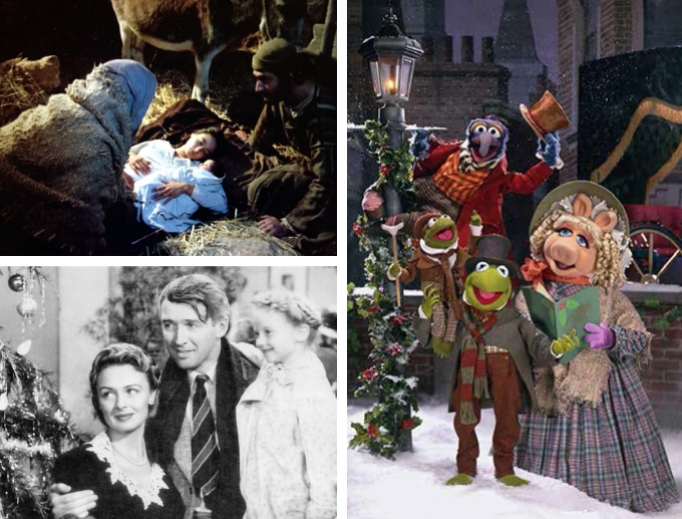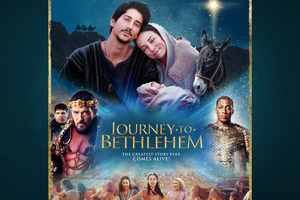What Is a Christmas Movie?
Timely viewing for the Advent and Nativity seasons.

What are the best movies to watch around Christmastime? What is a Christmas movie, anyway? Is a secular Christmas movie really a Christmas movie? Is it enough for a movie to be set at Christmastime, or must it be Christmassy in some further sense?
For me, such questions tend to bring me back to one of my earliest holiday memories: being at my grandparents’ house on Thanksgiving, watching WPIX’s annual broadcast of the 1934 Laurel and Hardy nursery-rhyme fantasy March of the Wooden Soldiers (AKA Babes in Toyland).
There was nothing Thanksgiving-y about March of the Wooden Soldiers. On the contrary, it is much more a Christmas movie: Santa Claus is a notable supporting character, and Christmas presents and toys for children are major plot elements.
On one level, this annual TV tradition reflected the sense in which the weeks from Thanksgiving to Christmas, or even from Halloween to New Year’s, were and are rolled into a semi-undifferentiated “holiday season,” with both religious and secular overtones, marked in those days by seasonal TV fare ranging from A Charlie Brown Christmas to It’s a Wonderful Life to The Wizard of Oz.
A Charlie Brown Christmas was one of the rare staples that explicitly invoked the religious reason for the season, with Linus’ iconic recitation from Luke 2. Even It’s a Wonderful Life, which I have watched every year for most of my life, got no closer to Bethlehem than Joseph’s heavenly voice-over and a closing rendition of Hark, the Herald Angels Sing.
Dickens’ A Christmas Carol managed even less.
“Mary, the Magi, and the Angels are replaced by ‘spirits’ of [Dickens’] own invention,” as C.S. Lewis observed, “and the animals present are not the ox and ass of the stable but the goose and turkey in the poulterer’s shop.”
But another great English apologist, G.K. Chesterton, saw A Christmas Carol in a more positive seasonal light. Chesterton found great significance in what he saw as Dickens’ defense, not of what Christians celebrate at Christmas, but of the way in which Christian society has historically celebrated it — of the uniquely merry, festival spirit of this holiday season.
While there may not be much (I wouldn’t necessarily say there is nothing) truly Christmassy in the religious sense about many seasonal staples like Home Alone, A Christmas Story or Elf, there is also nothing intrinsically religious about mince pies, eggnog, gingerbread or whatever seasonal treats you enjoy at Christmastime. (Likewise, there is no necessary connection between chocolate and the resurrection of Jesus.)
In one sense, then, holiday fare, including Christmas fare, has simply become whatever we regularly enjoy during the season in question — even if it’s fruitcake or Santa Claus Conquers the Martians. More high-mindedly, Handel’s Messiah is religious and Tchaikovsky’s Nutcracker is not, but there’s room in the Christmas season to enjoy performances of both.
Yet what if we only had The Nutcracker and not The Messiah? You might enjoy secular Christmas tunes like Deck the Halls, White Christmas and Let It Snow, but what if those were all we had — if there were no Hark, the Herald Angels Sing, no Joy to the World, no Silent Night?
Alas, the Christmas movie scene is about that grim.
There’s no shortage of excellent productions of A Christmas Carol, from Alastair Sim and George C. Scott to Mr. Magoo and the Muppets. Movies about Santa and snow, presents and holiday get-togethers abound. And we’ll always have Bedford Falls.
Yet more than 120 years after the birth of cinema, the world still awaits a single bona fide Christmas classic that is actually devoted to the birth of Christ.
To be sure, the Nativity made brief appearances in life-of-Christ movies, from early silents like The Life and Passion of Jesus Christ and From the Manger to the Cross to the 1960s productions King of Kings and The Greatest Story Ever Told.
More recent contributions include the 1999 TV movie Mary, Mother of Jesus, starring Christian Bale and Pernilla August (who also played the mother of miracle child Anakin Skywalker in The Phantom Menace); the 2006 film The Nativity Story, starring Oscar Isaac and Keisha Castle-Hughes; the 2012 Lux Vide production Mary of Nazareth, starring Alissa Jung; and, most recently, Tim Reckhart’s animated talking-animal comedy The Star.
Of these, The Nativity Story is the only one I’ve cared to watch more than once, despite its flaws. By far my favorite depiction of the Nativity, and the one my family revisits every year, is the first 105 minutes of Franco Zeffirelli’s Jesus of Nazareth (a production praised by Pope Paul VI as “an example of a fine use that can be made of the new ways of communication that God is offering man”).
Olivia Hussey’s Virgin Mary is my favorite screen depiction of the Mother of God, and the numinous Annunciation, with the presence and voice of the archangel implied rather than depicted, gives me chills. Peter Ustinov’s Herod the Great gives a magnificent, hilariously urbane speech illuminating Jewish religiosity and hope from an outside perspective.
Among the few irritations, Matthew’s Gospel is flagrantly and repeatedly contradicted in regard to the Magi, who avoid ever visiting the court of Herod, much to the latter’s indignation.
Jesus of Nazareth just before Christmas and It’s a Wonderful Life just after are fixed parts of our family’s holiday tradition. Before and after that, there’s some variation.
In the weeks of Advent, in keeping with the liturgical spirit of expectation (and the Old Testament focus of the familiar family Jesse tree devotion), we often watch Old Testament-themed fare like DreamWorks’ animated Torah, The Prince of Egypt, and its modest direct-to-home-video prequel, Joseph: King of Dreams; The Ten Commandments; or episodes from Testament: The Animated Bible or another Bible series. In the days just before Christmas, A Charlie Brown Christmas is a good call.
In the weeks after Christmas, anything Christmas-themed goes: at least one version of A Christmas Carol (our go-to version is the Muppets, but last year we watched the Disney one directed by Robert Zemeckis and starring Jim Carrey, which is fun in a theme-park-ride way); Home Alone; Miracle on 34th Street; and, yes, Die Hard (after the younger ones are in bed, of course).
Next year we might try Illumination’s new animated The Grinch — though never, of course, the Jim Carrey atrocity. I am also not a fan (as my rhyming review of Illumination’s Grinch indicates in the previous issue) of Christmas-themed Tim Allen fare, from the broken-family-film Santa Clause series to Christmas With the Kranks, etc.
We sometimes press on after Christmas into the rest of the first half of Jesus of Nazareth; the second half we usually save for Lenten and Easter viewing — a topic for another article.
Deacon Steven D. Greydanus is the Register’s film critic.
Editor's Note: This article was originally published November 30, 2018.

















